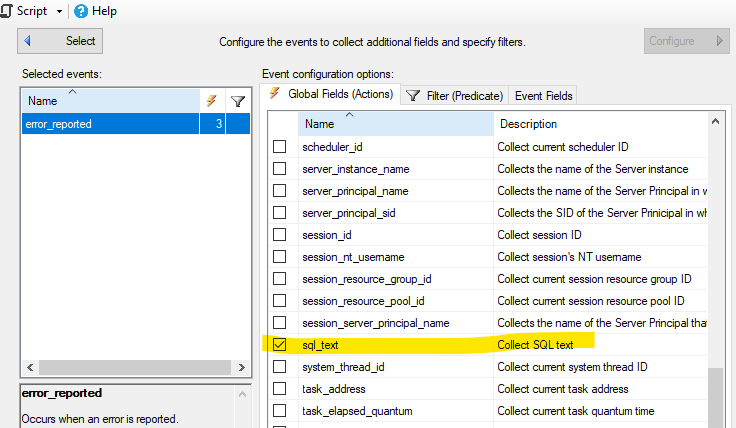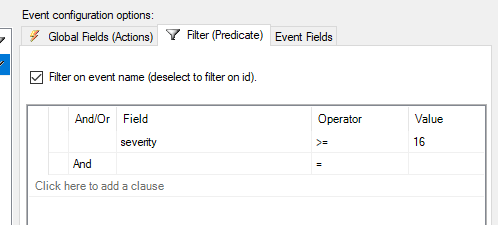So here's the table definition:
USE [FinancialSQL]
GO
/****** Object: Table [dbo].[Treatments] Script Date: 2023-08-31 16:48:19 ******/
SET ANSI_NULLS ON
GO
SET QUOTED_IDENTIFIER ON
GO
CREATE TABLE [dbo].[Treatments](
[ID] [int] IDENTITY(1,1) NOT NULL,
[TransactionID] [int] NULL,
[TreatmentDate] [int] NULL,
[TransactionTime] [int] NULL,
[Account] [int] NULL,
[Invoice] [int] NULL,
[Pro] [smallint] NULL,
[Room] [smallint] NULL,
[Code] [varchar](5) NULL,
[Tooth] [tinyint] NULL,
[Surface] [varchar](6) NULL,
[DentalFee] [float] NULL,
[LabFee] [float] NULL,
[TreatmentCategory] [smallint] NULL,
[Hidden] [tinyint] NULL,
[EntryType] [tinyint] NULL,
[TreatmentDescription] [varchar](max) NULL,
[IndependentAssociate] [smallint] NULL,
[MacroID] [smallint] NULL,
[Valid] [tinyint] NULL,
[OdontogramCode] [varchar](20) NULL,
[LabCode1] [varchar](5) NULL,
[LabFee1] [float] NULL,
[LabCode2] [varchar](5) NULL,
[LabFee2] [float] NULL,
[AssociateID] [smallint] NULL,
[Practice] [smallint] NULL,
[StdRate] [float] NULL,
[Counts] [smallint] NULL,
[Reference] [int] NULL,
[HIPLine] [tinyint] NULL,
CONSTRAINT [aaaaaTreatments_PK] PRIMARY KEY NONCLUSTERED
(
[ID] ASC
)WITH (PAD_INDEX = OFF, STATISTICS_NORECOMPUTE = OFF, IGNORE_DUP_KEY = OFF, ALLOW_ROW_LOCKS = ON, ALLOW_PAGE_LOCKS = ON, FILLFACTOR = 90, OPTIMIZE_FOR_SEQUENTIAL_KEY = OFF) ON [PRIMARY]
) ON [PRIMARY] TEXTIMAGE_ON [PRIMARY]
GO
ALTER TABLE [dbo].[Treatments] ADD DEFAULT ((0)) FOR [TransactionID]
GO
ALTER TABLE [dbo].[Treatments] ADD DEFAULT ((-1)) FOR [TreatmentDate]
GO
ALTER TABLE [dbo].[Treatments] ADD DEFAULT ((-1)) FOR [TransactionTime]
GO
ALTER TABLE [dbo].[Treatments] ADD DEFAULT ((0)) FOR [Account]
GO
ALTER TABLE [dbo].[Treatments] ADD DEFAULT ((0)) FOR [Invoice]
GO
ALTER TABLE [dbo].[Treatments] ADD DEFAULT ((0)) FOR [Pro]
GO
ALTER TABLE [dbo].[Treatments] ADD DEFAULT ((0)) FOR [Room]
GO
ALTER TABLE [dbo].[Treatments] ADD DEFAULT ((0)) FOR [Tooth]
GO
ALTER TABLE [dbo].[Treatments] ADD DEFAULT ((0)) FOR [DentalFee]
GO
ALTER TABLE [dbo].[Treatments] ADD DEFAULT ((0)) FOR [LabFee]
GO
ALTER TABLE [dbo].[Treatments] ADD DEFAULT ((0)) FOR [TreatmentCategory]
GO
ALTER TABLE [dbo].[Treatments] ADD DEFAULT ((0)) FOR [Hidden]
GO
ALTER TABLE [dbo].[Treatments] ADD DEFAULT ((0)) FOR [EntryType]
GO
ALTER TABLE [dbo].[Treatments] ADD DEFAULT ((1)) FOR [IndependentAssociate]
GO
ALTER TABLE [dbo].[Treatments] ADD DEFAULT ((0)) FOR [MacroID]
GO
ALTER TABLE [dbo].[Treatments] ADD DEFAULT ((1)) FOR [Valid]
GO
ALTER TABLE [dbo].[Treatments] ADD DEFAULT ((0)) FOR [LabFee1]
GO
ALTER TABLE [dbo].[Treatments] ADD DEFAULT ((0)) FOR [LabFee2]
GO
ALTER TABLE [dbo].[Treatments] ADD DEFAULT ((0)) FOR [AssociateID]
GO
ALTER TABLE [dbo].[Treatments] ADD DEFAULT ((1)) FOR [Practice]
GO
Keys
USE [FinancialSQL]
GO
/****** Object: Index [aaaaaTreatments_PK] Script Date: 2023-08-31 16:50:52 ******/
ALTER TABLE [dbo].[Treatments] ADD CONSTRAINT [aaaaaTreatments_PK] PRIMARY KEY NONCLUSTERED
(
[ID] ASC
)WITH (PAD_INDEX = OFF, STATISTICS_NORECOMPUTE = OFF, SORT_IN_TEMPDB = OFF, IGNORE_DUP_KEY = OFF, ONLINE = OFF, ALLOW_ROW_LOCKS = ON, ALLOW_PAGE_LOCKS = ON, FILLFACTOR = 90, OPTIMIZE_FOR_SEQUENTIAL_KEY = OFF) ON [PRIMARY]
GO
- No constraints on the Code column.
- No triggers on the table.
- No indexes on the Code column.


